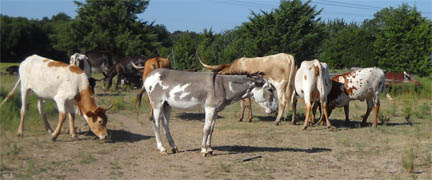Farm & Ranch
Why predators fear the long ears: Donkeys are proving their versatility as guard animals

By Martin Aldridge
“They keep them out of the pasture,” says Yvette Garza of Celina.
She’s talking about her three donkeys, and what they keep out of the pasture are the ever changing pack of dogs she fosters as founder of Lost Paws Rescue of Texas, a non-profit organization that rescues and adopts out all manner of canines and felines. New dogs, she says, learn quickly the pasture is off limits.
Garza describes her donkeys as “spoiled” and hasn’t really considered them as guarding anything, though she admits the chicken coop doesn’t attract much trouble, something she attributes to her long-eared friends. But even so, the behavior these donkeys display is one of the main reasons the use of guard donkeys is becoming increasingly popular.
“Donkeys aren’t guarding the cattle or sheep, per se,” says Leah Patton of the American Donkey & Mule Society, headquartered in Lewisville. “They are defending their family flock from predators.
“The donkey doesn’t care whether the herd baas or moos or grunts,” she says. “The donkey is concerned with the dog or coyote that is lurking. Whatever animal the donkey is bonded with, it will defend. Donkeys can do just fine with sheep, goats, cattle, llamas, horses, ponies – some people even say with chickens or other fowl.”
Patton should know – she has raised guard donkeys as well as used them with her cattle.
Yet despite the growing awareness of donkeys’ ability to guard livestock, the concept is a very old one.
“Shepherds have used donkeys to aid them in tending flocks for many centuries,” Patton says. “The donkey helped elevate the shepherd a little, extending his viewing area, allowed him to move a little faster, further and longer, and if need be, carry extra supplies. This practice has probably been going on as long as people have had donkeys as beasts of burden, and kept flocks of sheep.”
The current trend for using guard donkeys is indeed connected with a desire to protect sheep and goats. In the past, predators were largely controlled by using various poisons, but the passage of a federal ban against all toxicants in 1972 (since relaxed somewhat), as well as growing public disapproval against killing predators, left shepherds scrambling for alternatives.
Texas leads the nation not only in cattle, but in sheep and goats as well, so it’s no surprise some of the best information regarding the effectiveness of guard donkeys comes from the Texas Department of Agriculture (TDA). To read more pick up the April 2014 issue of North Texas Farm & Ranch.
Farm & Ranch
Hazards of Backyard Poultry

By Barry Whitworth, DVM
Having backyard poultry is a popular agriculture enterprise. According to the United States Department of Agriculture, 0.8 percent of all households in the United States have chickens. People keep chickens for a variety of reasons with table eggs being one of the more common reasons.
Unfortunately, some of these poultry producers are not aware of the hazards that come with keeping poultry because many times they carry pathogens but appear healthy.
Chickens are carriers of several zoonotic diseases. These are diseases that can be passed from animals to humans. According to a recent survey in Pennsylvania, a majority of backyard poultry producers were aware of the dangers of avian influenza. However, this study also revealed that far fewer producers were aware of the risk of possible exposure to Salmonella and Campylobacter.
The lack of knowledge about the hazards of raising poultry likely contributes to the continued issues of Salmonella outbreaks associated with backyard poultry. In 2023, the Centers for Disease Control and Prevention reported 1,072 illnesses of Salmonella linked to backyard poultry, and 272 of those patients required hospitalization. Oklahoma reported 43 individuals with the disease.
To read more, pick up a copy of the April issue of NTFR magazine. To subscribe by mail, call 940-872-5922.
Farm & Ranch
Ag Elsewhere: Wyoming

By Tressa Lawrence
Babies are tucked away in every nook and cranny. Many ranchers across Wyoming have baby animals popping up all over this time of year.
Farm & Ranch
Ag Elsewhere: Montana

By Lindsey Monk
Another load of grain in to keep feeding the calves until the green grass can really start popping.
-

 Country Lifestyles1 year ago
Country Lifestyles1 year agoScott & Stacey Schumacher: A Growth Mindset
-

 Equine7 months ago
Equine7 months agoThe Will to Win
-

 Country Lifestyles7 years ago
Country Lifestyles7 years agoStyle Your Profile – What your style cowboy hat says about you and new trends in 2017
-

 Country Lifestyles4 years ago
Country Lifestyles4 years agoAmber Crawford, Breakaway Roper
-

 HOME7 years ago
HOME7 years agoGrazing North Texas – Wilman Lovegrass
-

 Country Lifestyles7 years ago
Country Lifestyles7 years agoDecember 2016 Profile, Rusty Riddle – The Riddle Way
-

 Country Lifestyles8 years ago
Country Lifestyles8 years agoJune 2016 Profile – The man behind the mic: Bob Tallman
-

 Outdoor9 years ago
Outdoor9 years agoButtercup or Primrose?






